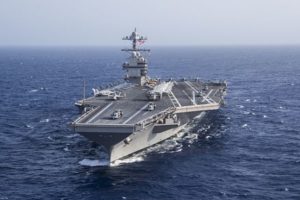The latest report from the Pentagon’s top weapons tester doubts the newest aircraft carrier, the USS Gerald R. Ford (CVN-78), can meet its sortie generation rate (SGR) requirement and achieve a self-defense requirement, but a Navy official recently said the goals are achievable.
“CVN-78 is unlikely to achieve its SGR requirement. The target SGR threshold is well above achieved historical rates and based on unrealistic assumptions, including fair weather and unlimited visibility, along with the expectation that aircraft emergencies, failures of shipboard equipment, ship maneuvers, and manning shortfalls will not negatively affect flight operations,” the FY ‘21 annual report from the Director, Operational Test and Evaluation (DOT&E) said.
The latest annual report was released on Jan. 27. It summarizes the developmental testing status of the Defense Department’s highest profile weapons systems.
“Poor reliability of key systems that support sortie generation on CVN-78 could cause a cascading series of delays during flight operations that would likely negatively affect CVN-78’s ability to generate sorties. The reliability of these critical subsystems represents the most risk to the successful completion of CVN-78 [Initial Operational Test and Evaluation], the report continued.
However, a Navy official recently said the service believes the goals are achievable and even reached or exceeded them during 12 to 24 hour periods during the 18-month Post-Delivery Test and Trials (PDT&T) period that concluded last April.
“As we were out there, we did not have a full air wing out there, we weren’t discretely trying to measure against the sortie generation rate because it was system qualification and pilot qualification. However, there was more than one period of time during the underways with 50 percent of an airwing aboard [when] we exceeded the sortie generation rate requirements,” Rear Adm. James Downey, program executive officer for carriers, told reporters during a press call on Jan. 21.
“You know, as you get into the 160-plus, those type of numbers, in those hours, where we were doing cyclical operations, we were able to meet or beat the general sortie generation requirements, while that wasn’t the focus of the effort. I think we’re going to continue to learn more about all that,” he continued.

Downey said the CVN-78 in-line refueling system that moves aircraft more towards a NASCAR-style pit stop approach allows the carrier to keep aircraft flying with better turnaround and with further work the Navy expects to meet the SGR.
“We have more reps to go, of course, that’ll be part of the future tasking for Ford as she goes out and back on this effort, but in some cases while we were not trying to… we certainly measured all of that, so we feel pretty comfortable that with a full air wing and focus on cyclic ops, those goals are achievable.”
After finishing the PDT&T periods, the Ford completed its full ship shock trials period in August and is currently undergoing a planned six-month Planned Incremental Availability to fix damage for the shock trials, conduct further inspections, and continue remaining modernization work (Defense Daily, Aug. 10, 2021)
The DOT&E report was also critical of the carrier’s capability to defend against anti-ship cruise missiles (ASCMs).
The Navy conducted the self-defense test ship phase of CVN-78’s integrated combat system operational test by using supersonic ASCM surrogates, completing three of the four self-defense test ship tests in the DOT&E-approved test plan.
However, the report noted the tests conducted “deviated from the approved test plan, Testing was not adequate to assess the combat system’s capability against supersonic ASCMs and subsonic maneuvering ASCMs, and there are no future test events planned that could provide additional data against these threats.”
The report said DOT&E will issue an interim assessment of the ship’s self-defense capability in FY ‘22.
The report also said only a limited assessment of the carrier’s combat system effectiveness is even possible. Back in 2008 a DOT&E-approved plan called for using Zumwalt-class destroyer (DDG-100) combat system performance data to supplement the evaluation of the Ford’s combat system.
“However, the redesigned DDG-1000 system differs significantly from the CVN-78 system. The Navy did not supplement the CVN-78 test campaign to compensate for the 10 test events it originally expected to leverage from DDG-1000 testing.”
The report noted the Navy tested the CVN-78’s combat system during the Combat Systems Ship’s Qualification Trials (CSSQT) and combat systems operational rehearsal events, but “this testing was not covered by a DOT&E‑approved test plan.”
Downey said that in practice CVN-78 has now demonstrated it can defend against the threats it was designed to defeat.
“We’ve been engaged in…a wide range of threats that are – she’s been engaged against her required threats. We’ve done those tests at sea, they’ve been evaluated and she’s achieved her certifications in the combat systems area.”
He said the Navy actually added more systems to the Ford as part of a normal modernization plan during the current Planned Incremental Availability period, notably the Mk 38 gun systems.